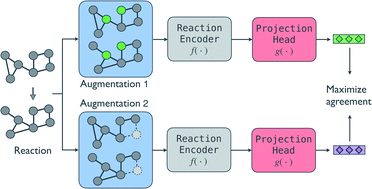Improving machine learning performance on small chemical reaction data with unsupervised contrastive pretraining†
Abstract
Machine learning (ML) methods have great potential to transform chemical discovery by accelerating the exploration of chemical space and drawing scientific insights from data. However, modern chemical reaction ML models, such as those based on graph neural networks (GNNs), must be trained on a large amount of labelled data in order to avoid overfitting the data and thus possessing low accuracy and transferability. In this work, we propose a strategy to leverage unlabelled data to learn accurate ML models for small labelled chemical reaction data. We focus on an old and prominent problem—classifying reactions into distinct families—and build a GNN model for this task. We first pretrain the model on unlabelled reaction data using unsupervised contrastive learning and then fine-tune it on a small number of labelled reactions. The contrastive pretraining learns by making the representations of two augmented versions of a reaction similar to each other but distinct from other reactions. We propose chemically consistent reaction augmentation methods that protect the reaction center and find they are the key for the model to extract relevant information from unlabelled data to aid the reaction classification task. The transfer learned model outperforms a supervised model trained from scratch by a large margin. Further, it consistently performs better than models based on traditional rule-driven reaction fingerprints, which have long been the default choice for small datasets, as well as those based on reaction fingerprints derived from masked language modelling. In addition to reaction classification, the effectiveness of the strategy is tested on regression datasets; the learned GNN-based reaction fingerprints can also be used to navigate the chemical reaction space, which we demonstrate by querying for similar reactions. The strategy can be readily applied to other predictive reaction problems to uncover the power of unlabelled data for learning better models with a limited supply of labels.

- This article is part of the themed collections: Machine Learning and Artificial Intelligence: A cross-journal collection and Most popular 2022 physical and theoretical chemistry articles


 Please wait while we load your content...
Please wait while we load your content...